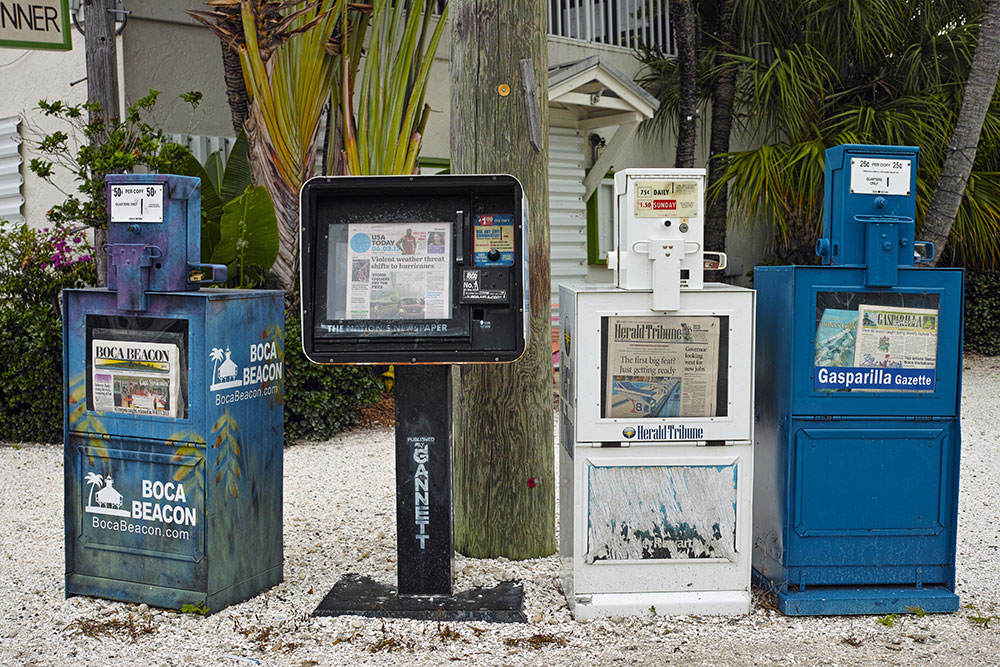The office building four blocks from Florida’s state Capitol carries the same name in bold letters that it boasted when it opened in 1988: Florida Press Center.
For the last 30 years, the modest three-story structure with its bland façade has been home to Florida’s statehouse press corps. The building was constructed by a consortium of local newspapers for the single purpose of housing the working media.
As a cub reporter, I can remember when the Press Center was a must-attend stop for any politician hoping to win in Florida. Reporters competed to break stories about agency graft, political favoritism, and cutthroat corruption. The rivalry within the building was so fierce that reporters would hesitate to invite a source to their offices, because they were wary about a competitor getting wind of a scoop.
Much has been written about the decline in the ranks of government reporters, but less is said about the impact that is having on government
Today, the hallways of the Florida Press Center are quiet. Few politicians make their way through the building and only seven news organizations are still housed there—two of them digital-only operations that didn’t exist a decade ago. The new building owner has repurposed the mostly-vacant building to house other businesses that have nothing to do with the media.
I’ll admit it: I don’t want to return to the pre-digital era. But the convenience, immediacy, and expanded reach of the Internet also brought with it a brutal devil’s bargain—the death of the newspaper model. Just as our building has been repurposed, so have the careers of many good journalists.
Much has been written about the decline in the ranks of government reporters, but less is said about the impact that is having on government. From my vantage point, that impact is even more menacing than the loss of our legacy newspapers because it has diminished government accountability, reduced access to accurate information, and, led to a decline in public trust.
I have spent a career as a state government reporter and bureau chief. The newsroom staff at my paper, the Miami Herald, is less than a third the size it was 15 years ago. Our parent company, McClatchy, has laid off more than 1,700 people since 2008 and, in 2018, offered buyouts to 450 more. This is not just a Florida story. The scenario playing out in Tallahassee is happening in statehouses and city halls across the country.
The change was almost imperceptible at first. As newsrooms cut their statehouse bureaus, they also reduced coverage of complex issues like utility and insurance regulation, giving them intermittent and often superficial attention. Elected officials no longer worried about the appearance of being aligned with special interests because few reporters were connecting the dots. We would write the occasional story about big donors shaping policy and influencing votes, but politicians would just wait us out—until our over-stretched staff left to chase the next big story.
The allure of social media also gave government a new tool to avoid reporters. In Kentucky, Governor Matt Bevin doesn’t have regular press conferences and generally avoids reporters, relying on social media to livestream his public events. Now Bevin is being sued by the ACLU of Kentucky for blocking people from viewing his official social media pages because they’ve made negative comments.
“It’s the most opaque administration in modern times,’’ says Al Cross, a former journalist who is director of the Institute for Rural Journalism and Community Issues at the University of Kentucky.
What passes for transparency has also changed. Former news reporters—who once populated jobs as government public information officers and saw their role as elevating access to information—have been increasingly replaced by people who see themselves as public relations gatekeepers and message managers. If a reporters’ request doesn’t fit the narrative their boss wants portrayed, these PIOs obstruct access to it. With fewer reporters, pushback is rare.
The perfect storm arrived in Florida in 2010. Newspapers had been gut-punched by the Great Recession and Rick Scott, a Republican health care executive who had never held public office, self-financed a long-shot bid for governor and won. In office, Scott routinely bypassed the capital press corps and used his private jet to swing into local communities where cooperative local television channels were given privileged access. Some reporters found it easiest to steer clear of stories critical of the Scott administration, and essentially practiced self-censorship.
With fewer government reporters at work, meetings don’t get covered and documents don’t get scrutiny. Florida is known for its Sunshine laws, with a state Constitution that guarantees the right to some of the most expansive public records and open meetings laws in the nation. But who’s watching? One Florida political consultant told me he advises his clients not to worry about accurately filling out their financial disclosure forms because “no one ever checks.”
So does the public increasingly distrust the media because it’s not doing its job, or is the media not doing its job because the public isn’t subscribing to local media? And why does this matter?
I spent the last year as a Nieman Fellow looking for answers and discovered a mounting body of academic research showing that how we engage and think about government is changing. Not enough of this research links these changes to the decline in local journalism, but my experience watching Florida government tells me that link is profound.
Researchers at Harvard have demonstrated that as the public increasingly relies on social media and national news for political information, where partisan cues are more intense than local news, it is more vulnerable to misinformation and manipulation. Then there’s the evidence that as local news disappears and political information becomes more nationalized, voter polarization increases. One key sign: split-ticket voting, the inclination of voters to choose candidates regardless of party affiliation, decreases in presidential and senatorial elections. Finally, more than one study has shown that decreased awareness in local and state politics leads to lower voter turnout and less civic engagement.
Even some politicians, who don’t always have a congenial relationship with the media, lament this trend. Sandy Weidner has been on the Common Council in Racine, Wisconsin, for nearly 20 years and says that as coverage of City Hall in the local paper diminished, the partisanship on the council increased.
“For those who have been around, they have lost their sight of what their role is,’’ she said. “For those that are new, they come in representing a party more than the public.”
What’s worse, she says, is that vigorous debate and different opinions are discouraged. “The marginalization of other perspectives is what is so dangerous to representative democracy.”
Former Miami-Dade Mayor Alex Penelas says that as his local paper, the Miami Herald, reduced the size of its government reporting staff, “people are less informed.” The Herald used to have reporters covering nearly a dozen major cities and neighborhoods in addition to the county, but the paper now has a total of four government reporters devoted to all those beats.
“Parties play a more important role as national politics penetrates local stuff,’’ Penelas says. “When I was mayor, my allies were Republicans and Democrats, even though I’m also a Democrat. Now, sanctuary cities and environmental issues have become partisan. None of these issues belong to parties. I don’t think that’s good.”
Government transparency is also a casualty when local journalism disappears. Lawyers for a waste management company argued in a Florida courtroom this spring that documents related to the Broward County recycling contract should not be open to the public. The reason? The case received coverage from only an online publication, Florida Bulldog, so “there is no actual public interest” in disclosing the documents, they said.
As Penny Abernathy, Knight Chair in Journalism and Digital Media Economics at the University of North Carolina, has pointed out, the problem in many places is not that newspapers have closed, but they have so diminished their staff that they have devolved into “ghost newspapers” with thin coverage. Covering government is more than just attending meetings. It’s also about covering the players, their motivations and power circles, pulling land transfers and nursing home inspections, reviewing court rulings and detailing plea agreements.
“A council meeting is like looking into a passing train,’’ says Cross of Kentucky. “You get a glimpse, but you don’t know what’s happening unless you get on and ask questions.”
Many newly elected officials now seem unaware of how to deal with the media, sometimes because they’ve never dealt with it before, or because they have the misperception that every reporter operates like prime-time cable news shows with a partisan bent.
Of course, nobody is keeping track of what could have been if newspapers hadn’t lost half their reporting staff in the last two decades.
In Sacramento, the school district budget was in so much trouble last year, the state threatened to take it over. In an ideal world there would have been reporters detailing the budget, providing the kind of watchdog function that would show there is a problem before it reached crisis mode. But at the McClatchy-owned Sacramento Bee, the K-12 education staff has gone from five to one and that person also covers higher education.
Local news outlets, despite all their economic woes, still remain the most significant providers of journalism in their communities
There is no academic research to measure the impact in the decline of journalism on corruption, but finance professors at the University of Illinois at Chicago and the University of Notre Dame found data that shows what it costs taxpayers. Their conclusion: when newspapers close, the loss of government monitoring can substantially increase the cost of local government for taxpayers. They found that with fewer watchdogs government salaries rise, deficits increase, and borrowing costs go up by 5 to 11 basis points. In dollar terms, an additional 10 basis points increases the cost of an average bond issue by $650,000.
I’ll be among the first to agree that the local news media is not without its flaws. It can be influenced by local political forces, powerful community leaders, and biased along social, racial, and ethnic fault lines. Local news reporting can be reactive and too dependent on self-interested sources. But as Rasmus Kleis Nielsen writes in the 2015 book “Local Journalism: The Decline of Newspapers and the Rise of Digital Media,” empirical research also suggests that even with its deficiencies, local journalism helps reduce government corruption, increases the responsiveness of elected officials to their constituents, and encourages public participation in local politics.
The 2,297-circulation Todd County Standard in Elkton, Kentucky regularly wins state awards for investigative reporting. It blew open a Cabinet agency for the management of its foster care system after a child in its custody was murdered. But the owner, Ryan Craig, sees its future dimming. His paper has no digital subscriptions; there is no retail center in town to sustain revenue, rack sales have declined 30 percent in recent years, and younger residents don’t buy the paper.
Most rural weeklies will be dead in five years, he predicts. “These large rural areas that are notorious for corruption, what’s going to happen when there is no one to watch them?’’ Craig asks.
The decline is so slow most people don’t notice. Many local newspapers still have enough of a pulse that big stories will find them. Local news outlets, despite all their economic woes, still remain the most significant providers of journalism in their communities.
A Duke University study of 663 radio stations, TV stations, newspapers, and online-only outlets across the country found that local newspapers still produced 50 percent of all original news stories—more than any of the other outlets combined.
There is a bit of hope. Experiments with different revenue sources are emerging at digital-only startups in larger cities. In Pennsylvania, for example, grant money is financing a new, collaborative approach to covering statehouse news. The nonprofit Spotlight PA is led by The Philadelphia Inquirer in partnership with the Pittsburgh Post-Gazette and PennLive/The Patriot-News and focuses on investigative and accountability reporting. The digital start-ups are also nonprofits or dependent on a blended revenue model that include subscriptions, sponsorships, and philanthropy.
This new blood is building the foundation for the press centers of the future and their names include the ProPublica Local Reporting Network, Report for America, CatchLight, and yet-to-be announced start-ups to be launched by the American Journalism Project.
Will the Florida Press Center still be housing journalists a decade from now? I don’t know. I do know that journalism tomorrow will be delivered in a very different package than what we have today and the for-profit model will be buried. My greatest hope is the net effect is a dramatic restoration in watchdog journalism and a return to the day when governments fear reporters, and local reporters fear rivals.
At a time of unprecedented polarization and partisanship, Nieman Reports is publishing a series of articles exploring how the crisis in local journalism is impacting communities in the run-up to the 2020 presidential election. Read all of the articles in the Election ’20: The Role of Local News series here.



